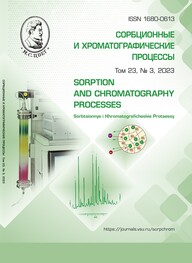Estimation of lipophilicity parameters of 3,5-di-tert-butylpyrocatechol by reverse phase HPLC
Abstract
Lipophilicity is one of the important parameters influencing the biological activity of compounds. In practice, this parameter is estimated using the distribution coefficient (logP) of the compound between the non-polar phase (n-octanol) and water. The main method of experimental determination of logP is the shaking flask method. However, in the case of the poor solubility of the studied compounds in water, the determination of logP using direct method is complicated, due to the difficulty of accurate determination of too low concentrations. In this case, indirect methods, including liquid chromatography, are successfully used for the estimation of logP. The lipophilicity of 12 new derivatives of 3,5-di-tert-butylpyrocatechol was determined using reverse-phase high-performance liquid chromatography. A methanol-water mixture was used as the mobile phase, and Separon Si C18 was used as the adsorbent. It is known that pyrocatechol derivatives have a wide range of biological activity; recently a large number of studies have been devoted to the investigation of their antioxidant properties. For each derivative of 3,5-di-tert-butylpyrocatechol (1-12) a linear relationship between the retention factor lg k and volume fraction of organic modifier φ in the mobile phase was established. By extrapolation of the retention to φ=0 using linear dependences, the lg k0 values were estimated and logP parameters were calculated. It was found that most of the studied derivatives of 3,5-di-tert-butylpyrocatechols have an octanol/water distribution coefficient log P in the range from 6 to 8. For compounds 1, 3, and 4 logP values turned out to be close to 4, which allows them to be considered as being promising for further study of antioxidant activity. Additionally, lipophilicity parameters log P of derivatives of 3,5-di-tert-butylpyrocatechol (1-12) were evaluated using the Kowwin and Molinspiration calculation methods. Comparison of experimental and calculated logP values showed good convergence of the results, while for most compounds the closest experimental and calculated values were shown by the Molinspiration method (the deviation did not exceed 10%).
Downloads
References
Arnott J.A.; Planey S.L. The influence of lipophilicity in drug discovery and de-sign, Expert Opin. Drug Discov., 2012; 7(10): 863-875. https://doi.org/10.1517/17460441.2012.714363
Soares J.X., Santos A., Fernandes C., Pinto M.M.M. Liquid chromatography on the different methods for the determination of lipophilicity: an essential analytical tool in medicinal chemistry, Chemosensors, 2022; 10(8): 340-380. https://doi.org/10.3390/chemosensors10080340
Sangster, J.M. Octanol-water partition coefficients: fundamentals and physical chemistry. Wiley series in solution chemistry. Chichester, Wiley, 1997, vol 2, p 170.
Camurri G., Zaramella A. High-throughput liquid chromatography/mass spectrometry method for the determination of the chromatographic hydrophobicity in-dex, Anal. Chem., 2001; 73(15): 3716-3722. https://doi.org/10.1021/ac001388j
Nikitin Yu.S., Petrova R.S. Experimental methods in adsorption and molecu-lar chromatography. Moscow, Moscow State University Publ., 2nd edition, 1990. 316 p. (In Russ.)
Xuan X., Xu L., Li L., Gao C., Li N. Determination of drug lipophilicity by phosphatidylcholine-modified microemulsion high-performance liquid chromatography. Int. J. Pharm., 2015; 490(1-2): 258-264. https://doi.org/10.1016/j.ijpharm.2015.05.019
Dechy-Cabaret O., Martin-Vaca B., Bourissou D. Controlled ring-opening polymerization of lactide and glycolide, Chem.Rev., 2004; 104(12): 6147-6176. https://doi.org/10.1021/cr040002s
Smolyaninov I.V., Burmistrova D.A., Arsenyev M.V., Polovinkina M.A., Po-mortseva N.P., Fukin G.K., Poddel’sky A.I., Berberova N.T. Synthesis and antioxidant activity of new catechol thioethers with the methylene linker, Molecules, 2022; 27(10): 3169-3190. https://doi.org/10.3390/molecules27103169
Candido Júnior J.R., Romeiro L.A.S., Marinho E.S., Monteiro N.K.V., de Lima-Neto P. Antioxidant activity of eugenol and its acetyl and nitroderivatives: the role of quinone intermediates – a DFT approach of DPPH test, J. Mol. Model., 2022; 28(5): 133-147. https://doi.org/10.1007/s00894-022-05120-z
Arsenyev M.V. New functionalized o-benzoquinones and poly-o-benzoquinones as precursors for polymer metal complexes and materials based on them. Diss. cand. chem. nauk. Nizhny Novgorod, 2014. Available at: https://diss.unn.ru/files/2014/423/diss-Arsenev-423.pdf (accessed 16 February 2023) (In Russ.)
Poddel'sky A.I., Arsenyev M.V., Astaf'eva T.V., Chesnokov S.A., Fukin G.K., Abakumov G.A. New sterically-hindered 6th-substituted 3,5-di-tert-butylcatechols/o-quinones with additional functional groups and their triphenylanti-mony(V) catecholates, J. Organomet. Chem., 2017; 835: 17-24. https://doi.org/10.1016/j.jorganchem.2017.02.035
Astaf'eva T., Arsenyev M., Rumyantcev R., Poddel'sky A., Fukin G., Cherkasov V. Imine-Based Catechols and o-Benzoquinones: Synthesis, Structure and Features of Redox Behaviour, ACS Omega, 2020; 5(35): 22179-22191. https://doi.org/10.1021/acsomega.0c02277
Arsenyev M.V., Khamaletdinova N.M., Baranov E.V., Chesnokov S.A., Cherkasov V.K. Synthesis, structures, and properties of new sterically hindered hy-drazine-based catecholaldimines, Russ. Chem. Bull., 2016; 7: 1805-1813. https://doi.org/10.1007/s11172-016-1514-9
GOST 32474-2013. Testing of chemicals of environmental hazard. //Moscow: Standardinform, 2014. Availa-ble at: https://files.stroyinf.ru/Data2/1/4293773/4293773041.pdf (accessed 28 February 2023). (In Russ.)
Mackay D., Shiu W-Y, Ma K-C, Lee S.C. Handbook of physical-chemical properties and environmental fate for organic chemicals. Available at: https://rushim.ru/books/spravochniki/mackay1.pdf (accessed 16 February 2023)
Meylan W.M., Howard P.H. Atom/fragment contribution method for esti-mating octanol-water partition coefficients, J. Pharm Sci., 1995; 84(1): 83-92. https://doi.org/10.1002/jps.2600840120
Interactive logP calculator. Availa-ble at: https://www.molinspiration.com/cgi-bin/properties (accessed 16 February 2023)
Braumann T. Determination of hydrophobic parameters by reversed-phase liquid chromatography: theory, experimental techniques, and application in stud-ies on quantitative structure-activity relationships, J. Chromatogr. A., 1986; 373: 191-225. https://doi.org/10.1016/S0021-9673(00)80213-7







